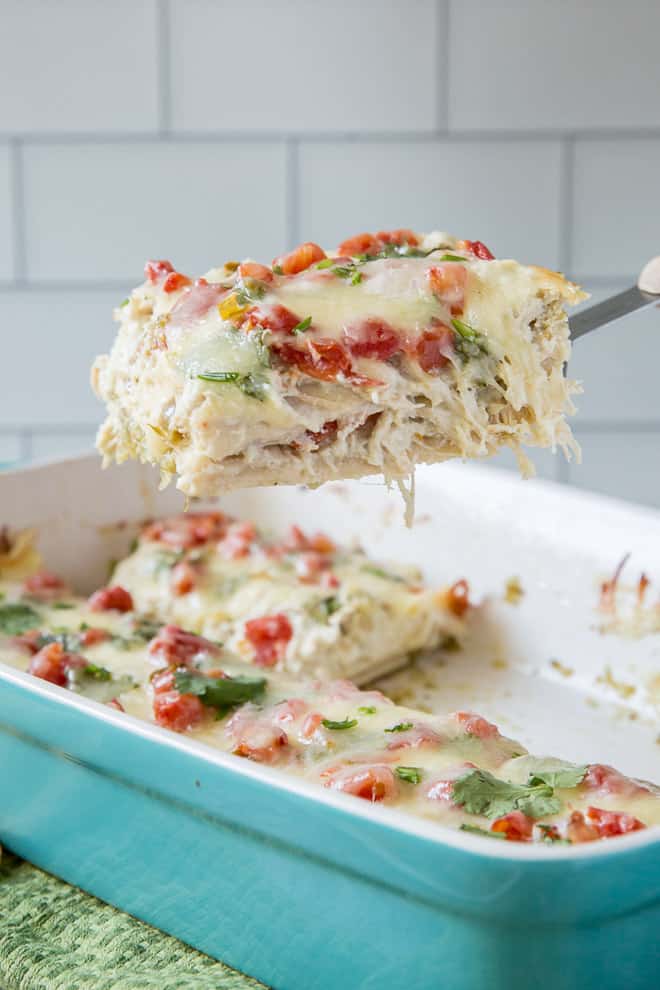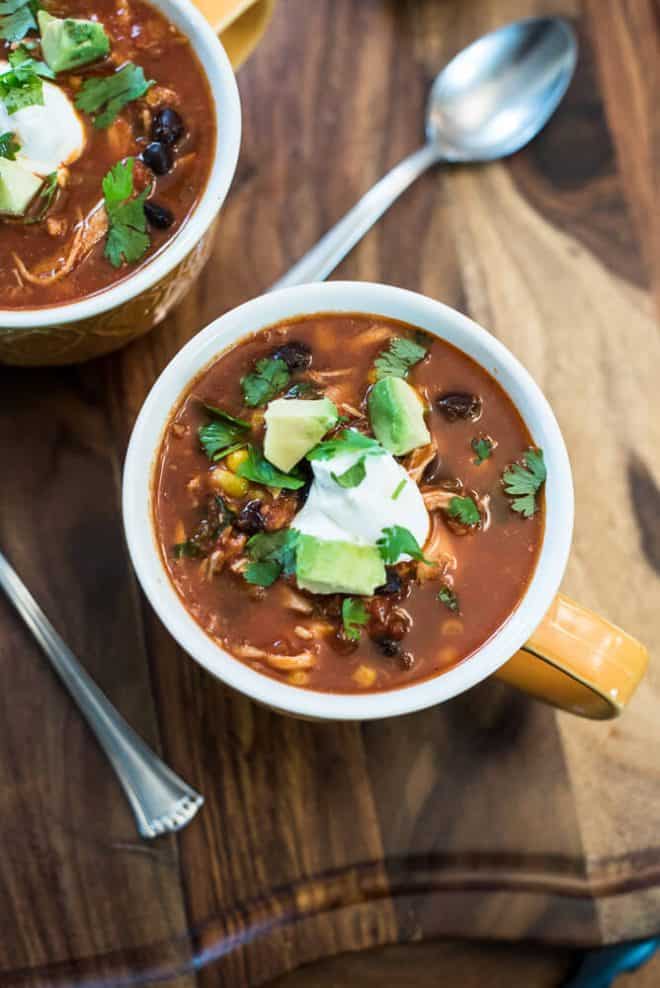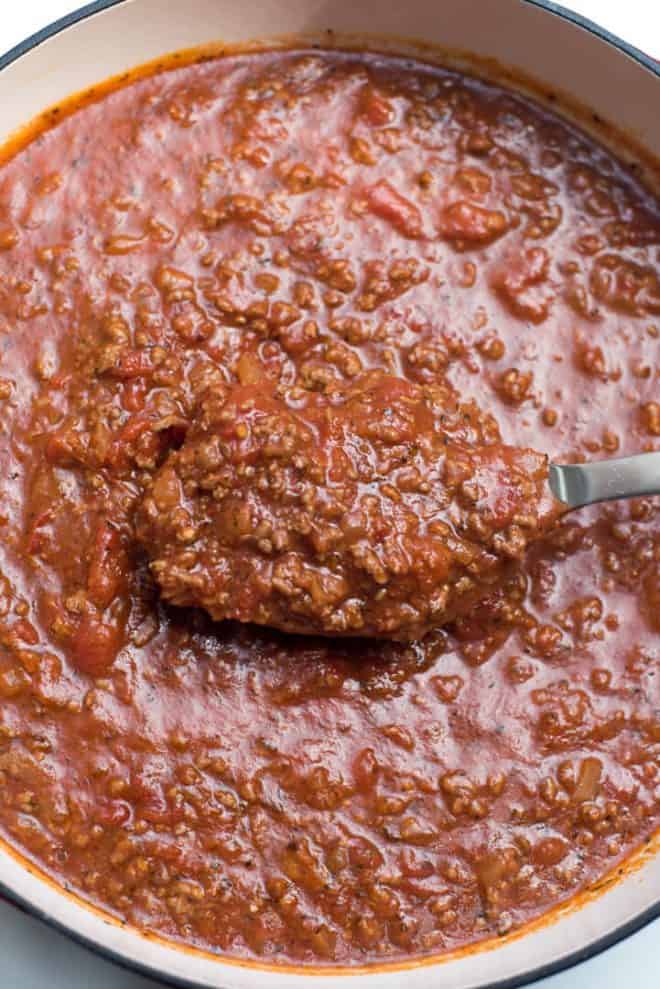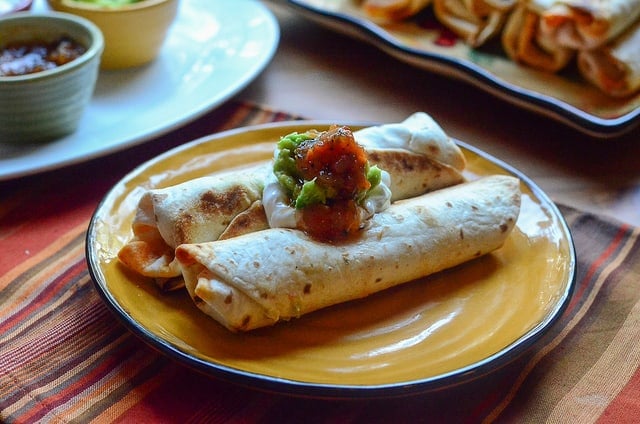All of the recipes in this collection of Easy Pantry Staple Recipes can be prepared with items you can easily stock. I’m also including lots of shopping and food storage tips so that hopefully we can spend less time at the grocery store and get more meals out of less effort.

I’ve had questions from many of you regarding the best way to prepare your kitchen during this difficult time so I’m sitting down this weekend with lots of coffee and some good music to write this post.
I think it’s important to remember that we are all collectively going through this experience together. It’s not one city or one state, but the world. Everyone is being affected in one way or another. While we know that social distancing is important to curb the spread of this virus, we can come together online in forums and on blogs to help each other feel connected and get through this.
At the end of this post you will find a list of my favorite recipes that call for what I consider to be pantry staples but first, let’s talk about what to buy and how to safely store your food.
Tips for a Well Stocked Kitchen
The list below is what I stock and should only be used for reference. You should only buy what your family will eat. Most importantly, buy realistically and not out of panic. Hoarding will just lead to waste and potentially make it harder for your neighbors to stock their kitchens.
A good rule of thumb for items like canned and dry goods is to stock enough to last 3 months. For the more perishable items, try to stock enough to last two weeks, if you have the space, and replenish as needed.
Pantry Staples
Canned and Jarred Goods
- Beans (kidney, pinto, black, cannellini, refried)
- Tomato sauce
- Tomato paste
- Crushed tomatoes
- Diced tomatoes
- Whole tomatoes
- Better than Bouillon Base (chicken, beef, vegetable)
- Condensed soups for recipes (Cream of Chicken/Cream of Mushroom)
- Ready to eat soups (Chicken Noodle, Tomato, etc.)
- Canned fruit in juice (not syrup)
- Peanut butter
- Jelly and fruit spreads
- Diced green chiles
- Jalepenos
- Hot sauce (like Cholula)
- Sliced/chopped black olives
- Evaporated milk
- Pasta sauce
- BBQ sauce
- Light soy sauce
- Minced garlic
Dry Goods and Baking Supplies
- White and brown rice
- Dry pasta (spaghetti, penne, rigatoni, fussili, orzo, etc.)
- Grains (oatmeal, barley, farro, couscous, quinoa)
- Bread crumbs
- Cereal and granola
- Tortillas and wraps
- All purpose flour
- Granulated/Powdered sugar
- Cornstarch
- Baking powder/Baking soda
- Cornbread mix
- Cake and brownie mixes
- Tortilla chips
- Dried fruits for snacking
- Nuts for baking and snacking
- Chocolate chips
- A good collection of dry spices
- Vanilla extract
- Jello and pudding mixes
- Vegetable and olive oil
- Vinegars (balsamic, cider, rice)
Freezer Staples
- Assorted frozen veggies (corn, peas, mixed, stir-fry)
- Vacuum sealed meats including rotisserie chicken (more details below)
- Frozen orange juice
- Freezer meals (homemade or store-bought)
- Ginger root
- Frozen tots or fries
- Ice cream/frozen yogurt
Refrigerator Staples
- Eggs
- Milk
- Butter
- Cheese (sharp cheddar/mozzarella/Monterey Jack/Parmesan/American)
- Sour cream
- Yogurt
- Cream cheese
- Bacon
- Sausage and/or hot dogs
Shelf Stable Veggies (see storage tips below)
- Onions
- Potatoes (regular and sweet)
- Bananas
- Tomatoes
- Lemons/Limes
Don’t forget the pups and kitties. Grab an extra bag of kibble and/or canned foods to keep on hand.
Online Shopping Services
If you are unable to shop or would just prefer not to, take advantage of online grocery delivery services like Instacart and Amazon Fresh. Most grocery stores like Safeway offer delivery now as well.
Food Storage Tips
Storing Fruits and Vegetables
To get the most life out of shelf stable items like onions, potatoes, bananas, tomatoes, lemons and limes keep them out of the refrigerator and store them in a cool, dry place with good ventilation. Remove them from plastic bags and instead place them in bins or paper or mesh bags. Potatoes, especially, will soften much more quickly if refrigerated.
Most other fruits and veggies and anything that has been sliced open should be promptly refrigerated. Read this article for more tips and food storage times on Real Simple.
Leafy greens and herbs can be wrapped in paper towels and placed in sealed plastic storage bags before storing them in the crisper drawer of your refrigerator. Store-bought bagged greens are a great way to go as well but check expiration dates before buying and use or toss accordingly.
Freezing Soups, Stews, Chilis, and Sauces
Transfer the completely cooled recipe into freezer safe gallon-sized zippered plastic storage bags. Push out the excess air and close the bags. Lay them flat in your freezer until frozen solid and then the bags can be stacked to save space. Avoid freezing them in a stack initially or you may have trouble separating them. Be sure to label the bags with the contents and date.
To reheat the frozen item remove the bags from the freezer and refrigerate them overnight to safely thaw. Thawed soup, stews, chilis and sauces can then be reheated in a saucepan on the stove over medium heat, or in the microwave.
Vacuum Sealing to the Rescue
If you know me, you know I’m a vacuum sealing veteran. I buy most of my meats in bulk at Costco and when I arrive home I portion the meat out and vacuum seal it. This is just my usual routine but in times like this it’s probably the most important thing you can do to limit shopping trips.
What you need to get started:
- Vaccum sealer (I own and love my Foodsaver brand appliances)
- Assorted bags
- Kitchen scale (Look for one with a removable bowl)
- Sharpies (Don’t forget to label and date all packages)
Meat and seafood I stock in my freezer (for the full list see my spreadsheet below):
- Ground beef/turkey/pork
- Top sirloin
- Beef for stew
- Chuck roast
- Rotisserie chicken (see note below)
- Boneless, skinless chicken breasts
- Boneless chicken thighs
- Pork tenderloin
- Salmon/mahi mahi/cod filets
- Shrimp
Costco’s rotisserie chickens are less than the cost of an uncooked bird and the work is done for you. I buy at least two on every visit and when I get home I remove the meat from the bone and package it up into 3-cup portions. This is one of the most value-packed purchases you can make at Costco, especially if you freeze the meat for use over time. If refrigerated, rotisserie chickens must be used within 2 to 3 days, but if frozen, the meat will be fresh and tasty for several months or more.
There is such a great variety of recipes to make with rotisserie chicken. Soups, stews, chili, casseroles, sandwiches, and more!
Recipes to Make with Rotisserie Chicken
Always refer to the Cold Food Storage Chart for the Federal food safety guidelines.
Keep a Freezer Inventory
I have the good fortune to have a second refrigerator/freezer in my garage so to make things easier I keep track of what I have on hand with a simple freezer inventory spreadsheet. After adding or removing anything I update it. I can check this list when menu planning or before I head to Costco so I know exactly what I’ve got and exactly what I need. This is vital for me in my job as a recipe developer/food blogger but also super handy for anyone feeding a big family.
I can access Google Sheets from my phone so this list is with me wherever I go. It’s an awesome tool.

All frozen meats and seafood should be safely thawed in your refrigerator overnight. Never leave frozen items on the counter to thaw.
Be Kind, Courteous, and Lend a Helping Hand
When you are out and about, smile at the people you pass. I can’t tell you how much this can lift a mood, both yours and the recipient’s. Tell your grocery store workers you appreciate them for being there. There are a lot of folks out there who deal with the public that could use a nice word or some simple gratitude.
If you are able to, offer to shop and/or cook for elderly neighbors or anyone who is in quarantine. Groceries and freezer meals can be dropped off at doorsteps with a nice note. Connect with your neighbors in email chains or neighborhood chat groups like Nextdoor.com to stay connected with what is going on in your neck of the woods.
Stay informed by checking the CDC website for updates.
Easy Pantry Staple Recipes
These are some of my favorite go-to recipes when I can’t make it to the store or just want to make use of what I have on hand. They utilize a lot of the ingredients on my pantry staple lists above with just a few fresh ingredients thrown in.


Chicken Tortilla Casserole with Salsa Verde






Chicken and Spinach Skillet Pasta




Green Chile Chicken Smothered Burritos



Freezer Friendly Beef and Bean Burritos

Skillet Sausage and White Beans with Spinach

Baked Chicken Teriyaki with Rice (stir fried frozen veggies on the side)

Tex-Mex Chicken and Rice Skillet



Kielbasa Baked Beans (over rice as a main)


















Thank you, thank you, thank you for your common sense approach! I am of an age that I was taught to use every last bit of any recipe and since I’m only feeding 2 of us now, I freeze portions of food to save it. However, many of my younger friends need exactly these instructions for saving food! Your list of common sense staples is great! Again, thank you, thank you! 😊
Vacuum sealers are just as useful to a house of 2 as they are to a house of 8! Thanks for your comment, Colleen 🙂
This is an awesome resource for keeping a well-stocked pantry and making sure no food goes to waste. The recipes look fantastic, too!
I’m so glad you think so. Thanks, Kim!